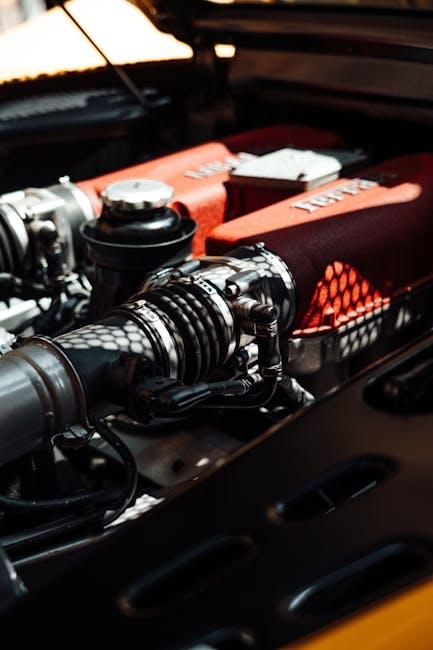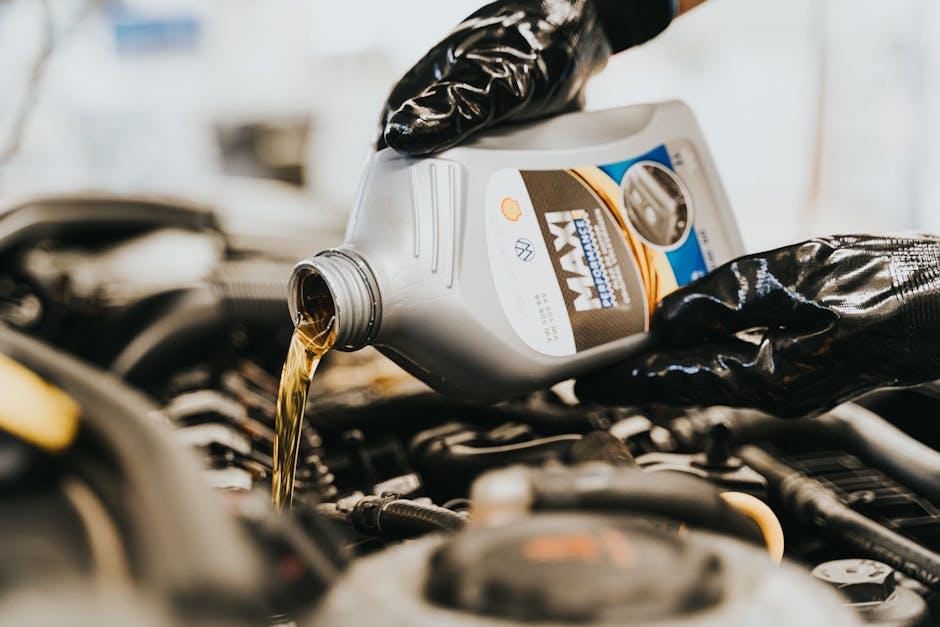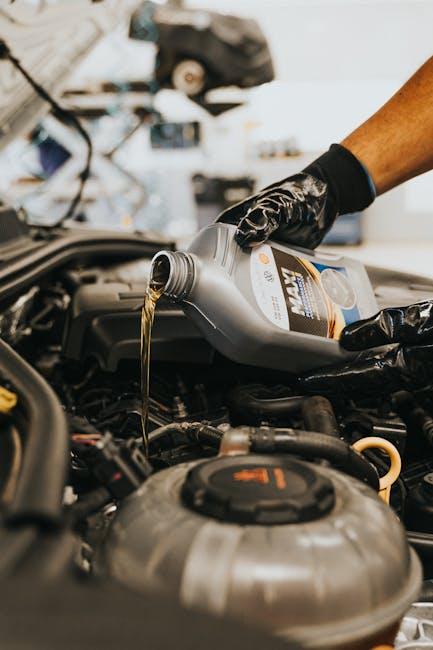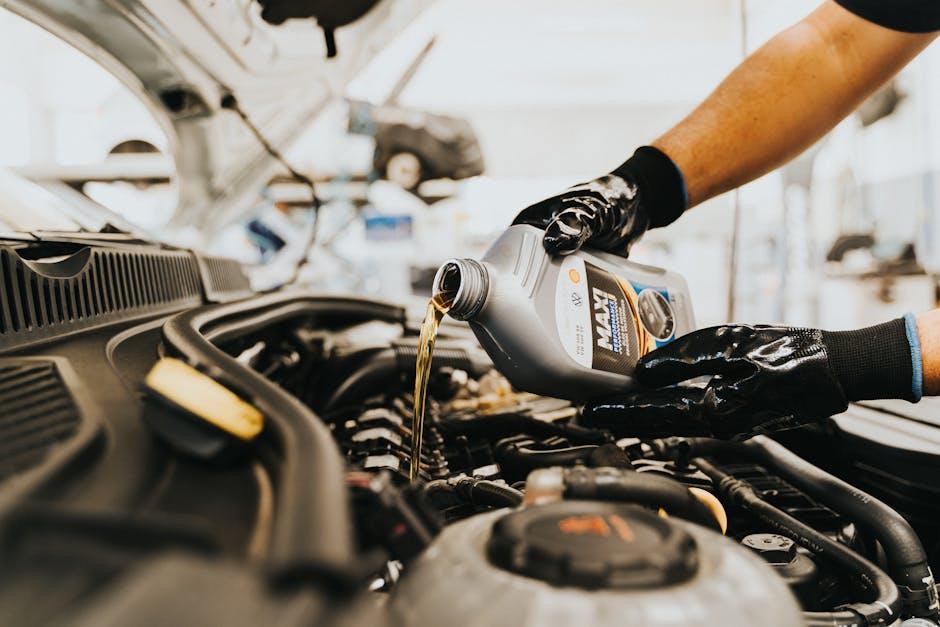Beneath the hood of every vehicle lies a complex dance of moving parts, working in harmony to carry us from place to place. At the heart of this intricate ballet is a humble but vital element: oil. Often overlooked, oil is the lifeblood that keeps engines running smoothly, reducing friction and preventing wear. Yet, like any essential resource, it requires careful attention and timely renewal. Regular oil changes might seem like a routine chore, but they play a crucial role in maintaining engine health, enhancing performance, and extending the life of your vehicle. In this article, we delve into why keeping up with oil changes is not just maintenance—it’s a smart investment in your car’s future.
Table of Contents
- The Role of Engine Oil in Vehicle Performance
- How Regular Oil Changes Prevent Costly Repairs
- Choosing the Right Oil for Your Car’s Needs
- Signs Your Vehicle Is Due for an Oil Change
- Step-by-Step Guide to Changing Your Oil at Home
- Maximizing Engine Life Through Consistent Maintenance
- Q&A
- Wrapping Up

The Role of Engine Oil in Vehicle Performance
Engine oil acts as the lifeblood of your vehicle’s engine, ensuring every moving part functions smoothly and efficiently. By creating a thin, protective film between metal components, it prevents friction, reduces wear, and helps keep the engine cool under intense operating conditions. Over time, however, oil breaks down and accumulates contaminants such as dirt, metal particles, and combustion byproducts, which compromise its ability to protect the engine effectively.
Regularly changing your oil is essential to maintaining optimal vehicle performance. Some of the key benefits include:
- Enhanced engine longevity: Clean oil dramatically decreases the wear and tear of engine components.
- Improved fuel efficiency: Reduced friction means your engine doesn’t need as much fuel to operate smoothly.
- Better engine cleanliness: Fresh oil helps prevent sludge buildup that can clog vital passages.
| Oil Change Interval | Vehicle Mileage | Performance Impact |
|---|---|---|
| Every 3,000 – 5,000 miles | Up to 100,000 miles | Optimal protection and efficiency |
| Every 7,500 miles | Under normal conditions | Balanced cost and performance |
| Over 10,000 miles | Potentially riskier | Higher wear and fuel consumption |

How Regular Oil Changes Prevent Costly Repairs
Consistently changing your vehicle’s oil is one of the simplest yet most effective ways to avoid unexpected and often expensive repairs. Oil lubricates the engine’s moving parts, reducing friction and preventing metal-on-metal contact that leads to premature wear. Over time, oil breaks down and becomes contaminated with dirt, debris, and combustion byproducts, which can cause sludge buildup. This sludge clogs engine components, leading to overheating and ultimately costly mechanical failures.
Maintaining fresh oil also helps keep critical engine parts clean, ensuring optimal performance and longevity. Here are some key benefits that regular oil changes provide:
- Enhanced engine efficiency: Clean oil improves fuel consumption by minimizing engine strain.
- Reduced wear and tear: Fresh oil prevents damage to valves, pistons, and bearings.
- Lower risk of breakdowns: Prevents issues that lead to expensive repairs, such as engine seizing or turbocharger failure.
| Repair Type | Potential Cost | Prevention |
|---|---|---|
| Engine Overhaul | $2,500 – $4,000 | Timely Oil Changes |
| Turbocharger Replacement | $1,000 – $2,500 | Proper Lubrication |
| Timing Chain Repair | $1,500 – $2,000 | Clean, Viscous Oil |

Choosing the Right Oil for Your Car’s Needs
Selecting the appropriate oil for your vehicle is more than just picking what’s on sale at your local auto shop. Every engine is designed with specific tolerances and operational environments in mind, which makes the type and grade of oil you use crucial. Synthetic oils often provide superior protection for high-performance engines or vehicles that operate in extreme temperatures, while conventional oils can be perfectly adequate for everyday driving with standard engine demands. Always consult your owner’s manual, but also consider your driving habits and local climate conditions when making your choice.
To simplify your decision, here’s a quick guide to common oil types and their best uses:
| Oil Type | Best For | Key Benefits |
|---|---|---|
| Conventional | Older engines & light mileage | Cost-effective, basic protection |
| Synthetic Blend | Moderate performance & mileage | Enhanced protection, improved viscosity |
| Full Synthetic | High-performance & extreme conditions | Maximum protection, longer intervals |
| High Mileage | Engines with over 75,000 miles | Seal conditioners, reduces leaks |
- Viscosity: Choose oil viscosity based on climate—thicker oils for high heat, thinner for cold starts.
- Additives: Some oils come with additives that help clean engine parts and prevent wear.
- Certification: Look for oils that meet industry standards like API SN or newer.

Signs Your Vehicle Is Due for an Oil Change
Your vehicle often gives subtle hints when it’s time to freshen up the oil. Keep an eye out for dim engine warning lights flashing on your dashboard, as these are often the first indicators. Another common sign is the change in engine noise; if your engine starts to sound louder or rougher than usual, it might be due to thickened oil failing to lubricate effectively. Additionally, pay attention to how the vehicle performs — if acceleration feels sluggish or the engine runs hotter than normal, your oil’s protective quality may be compromised.
Visual and tactile clues can also help you detect the right time for an oil change. When checking the dipstick, if the oil appears dark, gritty, or has a burnt smell, it’s overdue for a swap. You may also notice your car’s exhaust emitting more smoke than usual or even a slight drop in fuel efficiency. Below is a quick reference table to help distinguish typical oil conditions:
| Oil Condition | What It Indicates |
|---|---|
| Golden and Clear | Fresh and healthy oil |
| Dark and Opaque | Used but still serviceable |
| Thick and Sludgy | Needs immediate replacement |
| Burnt Smell | Overheated, poor lubrication |

Step-by-Step Guide to Changing Your Oil at Home
Changing your oil at home might seem daunting, but with the right approach, it’s a straightforward task that can save you money and enhance your vehicle’s longevity. Begin by ensuring you have all necessary tools: a wrench, oil filter wrench, drain pan, new oil, and a replacement oil filter. Always work on a cool engine and park your car on a flat surface. Start by lifting the front of your vehicle using jack stands or ramps for easy access to the drain plug. This simple preparation step lays the foundation for a smooth and safe oil change experience.
Once prepped, the actual process flows naturally when you follow these key steps:
- Drain the old oil: Remove the drain plug carefully and let the oil flow into your drain pan.
- Replace the oil filter: Use an oil filter wrench to remove the old filter, then lubricate the seal of the new one with some fresh oil before installing it.
- Refill with new oil: Add the correct type and amount of oil as specified in your owner’s manual.
- Check for leaks and oil level: After installation, start the engine and inspect for any leaks; adjust oil levels if necessary.
| Step | Time (approx) |
|---|---|
| Preparation | 10 minutes |
| Drain Oil | 5 minutes |
| Replace Filter | 7 minutes |
| Pour New Oil | 5 minutes |
| Clean Up & Check | 8 minutes |

Maximizing Engine Life Through Consistent Maintenance
Consistent care is the cornerstone of extending your engine’s longevity. By sticking to a disciplined maintenance schedule, you prevent the gradual build-up of contaminants and sludge that can choke your engine’s vital components. Regularly topping up with the right oil type ensures optimal lubrication, reducing friction and wear that happen naturally over time. This practice not only keeps every moving part synchronized but also maintains the engine’s efficiency, improving fuel economy and reducing harmful emissions.
Beyond lubrication, routine oil changes help in dissipating heat and protecting sensitive engine surfaces against corrosion and rust. Ignoring this essential step risks damaging costly parts such as the crankshaft and camshaft, leading to major repairs. Consider these benefits at a glance:
- Improved Engine Performance: Keeps internal parts moving smoothly.
- Extended Component Lifespan: Prevents early mechanical failures.
- Fuel Efficiency Boost: Reduces unnecessary fuel consumption.
- Lower Repair Costs: Less frequent breakdowns and component replacements.
| Maintenance Interval | Recommended Oil Type | Expected Benefits |
|---|---|---|
| Every 5,000 miles | Conventional | Basic protection & budget-friendly |
| Every 7,500 miles | Synthetic Blend | Better wear resistance |
| Every 10,000 miles | Full Synthetic | Maximum engine protection |
Q&A
Q&A: The Importance of Regular Oil Changes
Q1: Why is engine oil important for my vehicle?
A1: Engine oil acts like the lifeblood of your car’s engine. It lubricates moving parts, reduces friction, prevents overheating, and helps keep the engine clean by carrying away dirt and debris. Without proper oil, your engine can wear down quickly and ultimately fail.
Q2: How often should I change my oil?
A2: While traditional advice often suggests every 3,000 miles, most modern vehicles can go between 5,000 to 7,500 miles or even longer with synthetic oils. Always refer to your owner’s manual for the manufacturer’s recommended intervals, as factors like driving habits and conditions can affect frequency.
Q3: What happens if I neglect regular oil changes?
A3: Over time, oil breaks down and becomes contaminated with dirt, metal particles, and sludge. Neglecting oil changes can lead to increased engine wear, reduced efficiency, overheating, and expensive repairs. Eventually, it can cause your engine to seize or fail entirely.
Q4: Can I just top up my oil instead of changing it?
A4: Topping up oil is not a substitute for an oil change. While it helps maintain the right oil level, it doesn’t remove the degraded oil and contaminants. Regular oil changes replace old oil with fresh, clean oil, ensuring optimal engine performance.
Q5: Does the type of oil matter?
A5: Yes, the type of oil impacts how well your engine performs and lasts. Conventional, synthetic blend, and full synthetic oils have different properties. Synthetic oils typically offer better protection, longevity, and performance, especially under extreme conditions. Follow your vehicle manufacturer’s recommendations for oil type.
Q6: How do regular oil changes save me money?
A6: Regular oil changes prevent costly engine damage by maintaining proper lubrication and cleaning. They help your engine run efficiently, prolonging its lifespan and improving fuel economy. In the long run, they’re a small investment that can save you from major repairs.
Q7: Can I change my oil myself, or should I go to a professional?
A7: Changing oil yourself is possible if you have the right tools and knowledge, but it requires proper disposal of used oil and adherence to safety procedures. Many people prefer professional service for convenience, quality assurance, and to ensure the job is done correctly.
Regular oil changes might seem like a simple chore, but they are a crucial ritual that keeps your engine humming smoothly and extends the life of your vehicle. Treat your car to fresh oil on schedule—it’s the gift your engine will thank you for!
Wrapping Up
In the grand symphony of vehicle care, regular oil changes play a quietly powerful melody—one that keeps engines humming smoothly and journeys uninterrupted. By honoring this simple yet vital ritual, you not only extend the life of your trusted machine but also safeguard your adventures on the road ahead. So next time you hear that gentle reminder, treat it as a small investment in reliability, efficiency, and peace of mind. After all, every great drive begins with a well-oiled start.
